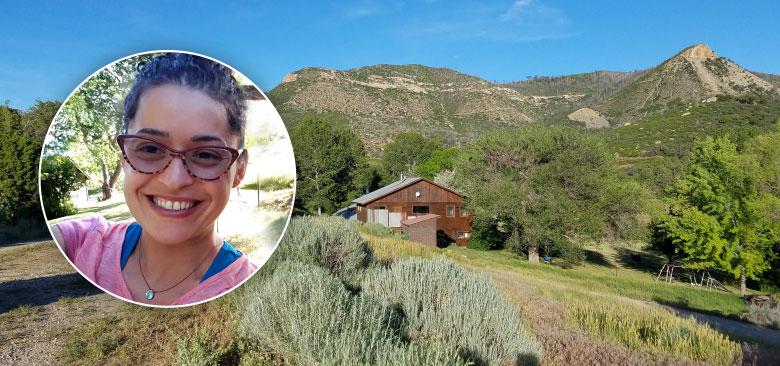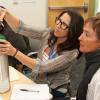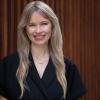
UCSF School of Nursing master’s degree student Jenny Mendez Butler volunteered this summer at the Adolescent Wellness Camp in Mancos, Colorado.
Navajo Area IHS Camp Delivers Powerful Learning
Camo Dibé Ni’tsaa is a four-day Adolescent Wellness Camp in Mancos, Colorado, that the Navajo Area Indian Health Service (NAIHS)’s Shiprock – Northern Navajo Medical Center runs each summer for Navajo Nation youth. With obesity and diabetes prominent in the Navajo population, the camp focuses on health education and traditional and cultural themes related to healthy lifestyle, as well as lots of outdoor physical activities, for campers aged 9 to 13.
When faculty in the UCSF School of Nursing Diabetes Minor began recruiting nursing students to participate as counselors for this summer’s camp, I leaped at the opportunity, and it was an enormously rewarding experience. (Maureen McGrath, who directs the UCSF Diabetes Minor, had conducted training at the IHS, and after discussions with the physician director of the diabetes center at Shiprock, she agreed to recruit volunteers for the camp; the minor funds the students’ airfare.) This was a one-of-a-kind opportunity to familiarize myself with Navajo culture and to work with one of the groups in America hit the hardest with diabetes.
A Focus on Healthy Living
Camp began when we met the families and the 50 young people at the Shiprock Youth Complex. The kids seemed shy, but I could sense their excitement as we traveled the one and a half hours from Shiprock to Mancos through a flat desert with silhouettes of canyon peaks in the distance. As we approached the camp, the landscape changed from desert to a lush green.
I was the counselor for the 10-year-old girls. Our days started around 6:15 a.m. By 7:30, we would head to a flat, grassy field where, after making a large circle, we said a morning blessing followed by stretching, a run or hike, and then breakfast in the big dining room. Around the field, deer and jackrabbits roamed while hawks soared. At night in that spot, the desert sky filled with stars.
After breakfast, we engaged in wellness education sessions that were interactive and fun, with themes that included body image, self-esteem, physical activity and nutrition. The session on sugary drinks stood out. First, the kids guessed how much sugar is in different commercial drinks. Then a hands-on exercise demonstrated how drinking one 12-ounce cup of soda daily equates to 35 pounds of sugar in a year, and this led to a discussion about how our bodies carry this sugar in extra weight. We encouraged the campers to “rethink your drink” by choosing water and, perhaps, adding fresh fruit for added flavor. We made creative combinations of fruits and herbs (grapes, strawberries, cucumbers, mint, lemon), and when my concoction also had an ant in it, the kids had a good laugh.
Sometimes, one of the “grandmothers” – older women who share advice and cultural beliefs to help the young people better understand their Navajo culture – would lead a session on traditional Navajo foods, encouraging the kids to explore and become familiar with these foods. Another session focused on how to read nutrition labels, and included an exercise in which the campers were challenged to figure out whether certain products represented healthy choices.
The physical activity sessions showed the campers that being active is fun. Zumba, balance and core strengthening, and yoga were some of the guided activities. Less-structured activities included mountain biking, swimming in the pond and hikes. In the mornings, groups rotated between different education sessions, all the while being reminded to drink water and wear sunscreen.
A healthy lunch – all meals were carefully planned to teach healthy nutrition – followed the morning sessions. Afternoons included games for team building, an obstacle course called Strong Warrior and free play. Campers played volleyball, basketball, kickball, softball, jump rope and Hula-Hoop. There were also crafts; one of the grandmothers taught pendant making.
In the evening, we all sat by a campfire and gave shout-outs to those who had made a difference in our day. Typically, a guest speaker shared his or her personal story of hard work and achievement. By 9 p.m. we headed for the showers and then our cabins, where we were asleep by 10.
A Cultural Education
Navajo culture, beliefs and pride wove through nearly every activity – especially those sessions led by the grandmothers and grandfathers. In one such session, a medicine man explained from a Navajo perspective how the sugar consumed in sweetened drinks poisons our blood and destroys our body, leading to diabetes; he also warned about the dangers of drugs and alcohol. He spoke about living in a mindful and purposeful way –respecting our bodies, respecting others and honoring the ancestral history. He also encouraged kids to know their four ancestral clans: maternal and paternal grandmothers; chei, or maternal grandfather; and nali, or paternal grandfather. The idea is that having a clear identity and a sense of belonging can support emotional and psychological health.
The sweat lodge was another traditional activity. This was one of the most special moments of camp for me because of the significance of taking part in the ceremony. We were separated by gender, and two grandmothers led the girls’ sweat lodge, inside of which approximately 15 girls and I sat closely together in a circle. There was a cycle of four rounds, each marked by the arrival of more hot rocks. One of the grandmothers brought fragrant sage she had handpicked from San Diego, and small amounts burned like incense on the hot rocks. During each round, we would shut the lodge entrance tight, so no amount of light could make it inside; I’d never experienced pitch darkness like this before, and I felt a momentary uneasy feeling, which quickly dissipated when I realized how special this experience was.
In round one, we introduced ourselves and our four clans; many of the kids spoke their native Navajo. Leaders scooped water over the hot rocks, and a light steam filled the lodge. On the second round, we said a prayer for whatever special request we had for the Creator. With each round, the steam was stronger, and sweat was running like streams on my face, back and chest. In round three, the two grandmothers sang a Navajo song accompanied by a drum, and later the girls joined in on a Navajo song they knew. We also sang “Amazing Grace,” for those who didn’t know the Navajo songs, and I joined in the singing, but in Spanish, since it’s my native language (I was born and raised in Guatemala). We passed fresh sage around the circle and took a piece and rubbed it on our skin. This had a refreshing and healing feeling for me. The fourth and final round was a prayer of gratitude. Then, just before opening the entrance to the lodge, one of the grandmothers encouraged us to scream out to the world as we stepped outside to represent being born from the mother’s womb again. I found the intimacy and connectedness of the shared experience of stories, prayers, songs and our struggle inside the hot lodge enormously moving.
Hoping for Lasting Impact
On the last day, the campers packed up in the morning, and by lunchtime – a campwide barbecue – families had arrived to pick up their kids. By then, we were one big family. The kids made many friends and learned about wellness concepts inside and out. Their Navajo pride strengthened. One of the Navajo nurses told me she usually sees the fruits of this camp’s effort many years down the road, when campers are in high school. She wonders how much of what the kids learn in camp impacts the home life, a potential research question to be explored.
In many ways, I felt as if I had traveled to a different country from the United States I know. There were some difficulties to endure: the altitude, the heat, dryness in the air and physical exhaustion, as well as some stress about being in camp during finals week and having projects due. But I tried to learn as much as I could from the Navajo people, and my heart is filled with the smiles of the kids, the love and wisdom of the elders, the enthusiasm of the Shiprock IHS staff – and a kind of serenity and insight I hadn’t even known I was missing.
Jenny Mendez Butler will be a second-year Adult-Gerontology Primary Care Nurse Practitioner master’s degree student at the UCSF School of Nursing in fall 2017.



